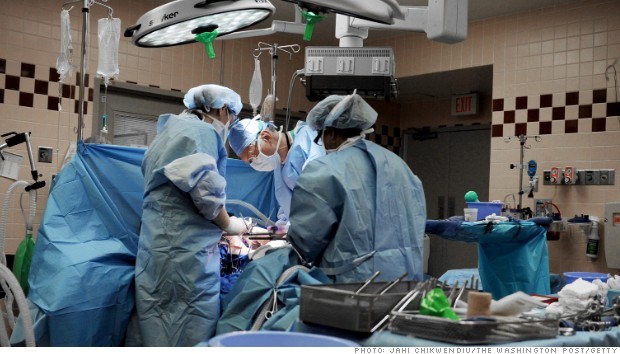A new study has found that hospitals benefit immensely from surgical complications. How employers like Wal-Mart and health care providers are tackling this problem.

FORTUNE — American health care is screwed up. It is a bizarre market where the prices that patients pay do not match the quality of care.
Unfortunately, that’s old news. What is new is the nitty-gritty — details about why hospitals might not have any financial incentive to follow best practices. A new paper from researchers affiliated with Harvard, Boston Consulting Group, and nonprofit health care delivery system Texas Health Resources suggests that, in some cases, providing worse care pays off for hospitals. On a hopeful note, some companies are stepping in to challenge the system.
The research group published a paper in the Journal of the American Medical Association on April 16 that looked at more than 34,000 surgical patients who were discharged from 12 hospitals in 2010. Out of those patients, 1,820 suffered at least one complication from surgery. Of course, patients with complications cost more to treat — they spend more time in the hospital and require resources like nurses and beds.
MORE: Coming to a workplace near you: Fines for being fat?
But the study found that these patients didn’t simply cost more to treat, but the majority of them generated a much larger profit for hospitals.
Privately insured patients with surgical complications delivered almost $40,000 more in profits (per patient) than privately insured patients who had no complications. The margin was smaller for patients with Medicare — those patients who had complications earned the hospital around $1,700 more than those who didn’t have any.
Hospitals didn’t make the same profit margins off of Medicaid patients or those who paid out of pocket, but combined, those two latter groups only accounted for 10% of the total population of patients studied.
That means 90% of surgical discharges at these hospitals during 2010 participated in a payment system that rewarded the hospital if patients faced at least one surgical complication.
“We are entering this phase of tremendous experimentation in changing the model of payment,” says Atul Gawande, the corresponding author on the paper who is also a surgeon at Brigham and Women’s Hospital in Boston, a professor of surgery at Harvard’s medical school, and a medical journalist.
“We have a bonus system here that we’ve known has rewarded perverse behavior, but now we’re able to put some real numbers on it, and it’s a bigger bonus than we’ve ever understood.”
Gawande has described parts of this flawed rewards system in his landmark story “The Cost Conundrum,” which explains some of the financial incentives that drive the discrepancy in the quality of care. Namely, at many hospitals, physicians earn money for every procedure or test performed, regardless of the outcome.
MORE: Ben and Jerry: Ice cream’s sweetest pair
This mismatch happens all the time in the corporate world — the stated goals of a company may say one thing, but the company could have conflicting systemic financial rewards in place. Take the rogue trader who lost UBS $2.3 billion in 2011. He messed up, but in general, traders are encouraged to take big risky bets, and are rewarded when those bets pay off for companies. Effective organizations not only proclaim their ideals in grand vision statements but reward the kinds of behavior that back up those ideals.
In the case of hospitals, some may argue that the number of complications is out of the administration’s hands. That isn’t necessarily true, Gawande says. There are checklists and procedures that, if enforced, can make surgery safer and reduce the number of complications. “This business case has been difficult to make,” he says. “It will always pay to open another operating room or increase number of patients.” But CEOs of medical centers have a tougher time seeing the payoff from investments to improve the quality of care.
CEOs in other industries are starting to place a premium on quality of health care, however. It makes sense — if employers are paying for health care, they want to pay for care at better, more efficient facilities that don’t have any incentive to charge for procedures that could be superfluous.
That’s why Wal-Mart (WMT) announced in 2012 that it would foot the entire bill for certain bundled treatments — heart, spine, and transplant surgeries — if employees go to one of six designated health care organizations for treatment. Bundling the treatments involves streamlining the billing process. Organizations that offer bundled treatments enable whoever is paying to avoid a major financial headache. Another draw of going with the selected organizations, says Wal-Mart spokesman Randy Hargrove, is that they prioritize patient outcome over patient volume and have low readmission rates.
Take, for example, the Cleveland Clinic in Ohio, which is one of the facilities included in Wal-Mart’s program. Doctors there are on salary. “Because physicians are employed and salaried, they don’t have a direct financial incentive to do a particular thing, but really to do what’s in the best interests of the patient,” says Michael McMillan, executive director of marketing and network services for the clinic.
MORE: Is there really such thing as a ‘global CEO’?
Pursuing the best interest of the patient — what an idea. Granted, Wal-Mart’s program is a new experiment. To last, it will probably have to both provide patients better care and save Wal-Mart money.
But it is a push against the grain in an otherwise broken system. Hospitals need not profit from sicker patients. It is a simple concept but a massive management challenge: reward physicians and institutions that are the best at keeping people well.
Sumber: management.fortune.cnn.com








